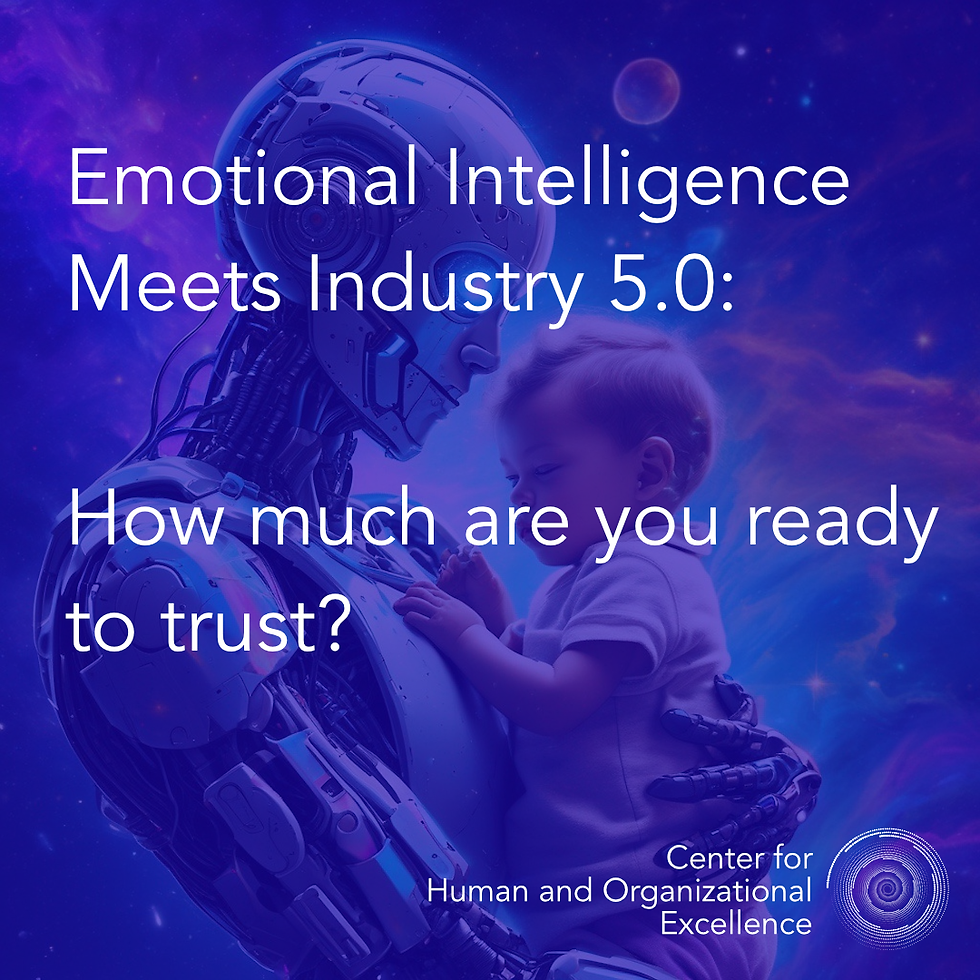In the rapidly evolving landscape of Industry 5.0, leaders face an unprecedented challenge: integrating human workers with an array of cyber elements, including nodes, sensors, production machines, bots, and evolving AI models. This integration entails a fundamental rethinking of traditional leadership paradigms, particularly in the realm of trust, emotional intelligence, and relationship building.

The Changing Face of Teams
Historically, organizational structures have been built upon human-to-human interactions, where emotional intelligence (EI) played a pivotal role in fostering trust. Leaders developed deep, empathetic connections with their team members through well-established paradigms such as the Leader-Member Exchange (LMX) and Social Exchange theories. These approaches emphasized the importance of emotional awareness, mutual understanding, and reciprocal relationships in building trust.
Leaders with high EI could perceive, understand, and manage emotions effectively, creating an environment of psychological safety and strong interpersonal bonds. However, as we venture into Industry 5.0, the definition of a "team" is expanding to include non-human entities, challenging our traditional notions of trust and emotional connection. This shift raises critical questions: How much should we trust our new cyber teammates? Can we develop "emotional intelligence" in AI systems to facilitate trust-building? How do we balance the logical, data-driven nature of cyber elements with the emotionally-influenced trust dynamics of human teams?
Challenges in Building Trust with Cyber Teammates
Lack of Emotional Reciprocity: While human team members rely on emotional cues and shared experiences to build trust, cyber elements lack this capacity for emotional exchange.
Transparency vs. Complexity: The decision-making processes of AI and complex systems may not always be transparent, contrasting with the value placed on emotional honesty in human interactions.
Reliability vs. Unpredictability: Cyber systems may be more reliable in certain tasks but can also evolve in unpredictable ways, challenging our ability to maintain consistent trust.
Data-Driven vs. Intuition-Based Trust: Human trust often relies on gut feelings and intuition, while trust in cyber systems is typically based on performance metrics and data.
Ethical Considerations: As AI becomes more advanced, questions about its ethical decision-making capabilities arise, potentially creating trust barriers with human team members.
Strategies for Building Trust in Industry 5.0
Develop AI Emotional Intelligence: Invest in research and development of AI systems that can recognize and respond to human emotions, bridging the gap between human and cyber team members.
Enhance Human-AI Interaction Skills: Train human team members in new competencies that blend emotional intelligence with technical understanding to better interact with cyber teammates.
Create Transparent AI Systems: Develop AI models that can explain their decision-making processes, fostering trust through increased transparency.
Implement Ethical AI Frameworks: Establish clear ethical guidelines for AI behavior and decision-making to align with human values and build trust.
Cultivate a Hybrid Team Culture: Foster a team culture that values both human emotional intelligence and AI capabilities, emphasizing their complementary strengths.
The Future of Trust and EI in Industry 5.0
As we navigate this new terrain, it's crucial to reimagine trust-building strategies that span the human-cyber divide. Leaders must cultivate a nuanced understanding of trust that incorporates both emotional and data-driven elements. This may involve:
Developing new models of emotional intelligence that apply to human-AI interactions.
Creating metrics that measure trust in hybrid teams, considering both emotional and performance-based factors.
Designing team-building exercises that foster connection between human and cyber team members.
Encouraging ongoing dialogue about the role of emotions and trust in human-AI collaborations.
Conclusion
The success of Industry 5.0 will depend on our ability to forge new models of trust and collaboration that honor the strengths of both human and cyber team members. By approaching this challenge with empathy, creativity, and a commitment to both emotional and artificial intelligence, leaders can pave the way for a more integrated, efficient, and emotionally aware future of work. As we continue to explore the boundaries of human-AI interaction, the very definitions of trust, emotional intelligence, and teamwork may evolve, opening new possibilities for organizational success in the age of Industry 5.0.
About the author:
Jerry Morla is an expert in virtual leadership with over two decades of experience leading global and distributed teams. His graduate-level research and publications focus on emerging management and virtual leadership models. Jerry holds an MBA and a Master of Science in Leadership.
This article was created by the author using AI-assisted writing tools. Original ideas and inputs were provided by the author and refined through AI collaboration.


Comments